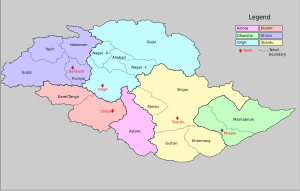Gilgit District
This 2014 needs additional citations for verification. (November 2016) |
Gilgit District | |
|---|---|
 Map of Gilgit–Baltistan, showing the six districts and tehsil boundaries. | |
| Country | Pakistan |
| Dependent territory | Gilgit–Baltistan |
| Capital | Gilgit |
| Established | July 1, 1970 |
| Area | |
| • Total | 38,000 km2 (15,000 sq mi) |
| Population (1998) | |
| • Total | 243,324 |
| • Density | 6.4/km2 (17/sq mi) |
| Time zone | UTC+5 (PST) |
| Number of Tehsils | 4 |
| Website | chital.gov.pk |

Gilgit District (Urdu: ضلع گلگت) is one of the districts of the Gilgit–Baltistan territory in northern Pakistan. It was formed in 1970 when Gilgit–Baltistan was federally administered as the "Northern Areas". It is bounded by the Wakhan Corridor (Afghanistan) to the north; Xinjiang (China) to the northeast and east; Skardu, Astore and Diamer to the south; and Ghizer District to the west. The town of Gilgit is the capital of Gilgit District. According to the 1998 census Gilgit District had a population of 243,324.
The district includes Gilgit town, Bagrot Valley, Juglot, Danyore, Naltar, and Nomal. The highest peak in the district is Distaghil Sar 7,885 metres (25,869 ft), which is the seventh-highest peak in Pakistan and 19th-highest on Earth.
Administration
The Government of Pakistan has recently changed the status of the Northern Areas through a constitutional order and has renamed it as the de facto province of Gilgit–Baltistan. The ceremonial head is the Governor Peer Karam Ali Shah, who is the constitutional head of provincial government, assisted an executive Chief Minister Syed Mehdi Shah and a council of ministers.
Administered by a tailor-made political and local government system. The local government system is based on a Legislative Council (Provincial Assembly), elected by people in all six districts through voting, headed by a speaker. Technocrats and women members are later elected/selected through a proper system.
Chief Secretary is administrative head of all departments, controlling all the affairs on behalf of chief minister Government of Pakistan.
Inspector General of Police, currently Mr Zafar Iqbal Awan, heads the police department, with deputy superintendents in all six districts.
Judiciary
The main judivial structure in Gilgit–Baltistan comprises a High Court, composed of three judges selected by the government, supported by the Supreme Appellate Court.
Education
According to the Alif Ailaan Pakistan District Education Rankings 2015, Gilgit is ranked 35 out of 148 districts in terms of education. For facilities and infrastructure, the district is ranked 67 out of 148.[1]
Geography
Only a part of the basin of the Gilgit River, i.e. Gilgit Valley, is included within the political boundaries of Gilgit District. There is an intervening width of mountainous country, represented chiefly by glaciers and ice fields, and intersected by narrow sterile valleys, measuring some 100 metres (330 ft) to 150 metres (490 ft) in width, to the north and north-east, which separates the province of Gilgit from the Chinese frontier beyond the Muztagh and Karakoram. Towering above Gilgit is Mount Rakaposhi at 7,788 metres (25,551 ft).
Rivers
The main rivers in the District are:
- Khunjerab River - flows south along the Karakoram Highway from the Khunjerab Valley, known as Hunza River in the south of Sust
- Hunza River - flows further south and falls into Gilgit River just in the northeast of Gilgit town
- Gilgit River - enters Gilgit District from west in the south of Bichhar Pass (Naltar Valley) and flows west through the Gilgit town.
- Indus River - enters Gilgit District from Skardu District about six kilometers north of Jaglot where Gilgit River falls into Indus River and the Indus flows south along the Karakoram Highway.
There are many tributaries of the above main rivers, some of which are Ghujerab River, Shimshal River, Hispar River, Naltar River and Yaheen River.
Passes
- Khunjerab Pass, Mintika Pass, Kilik Pass, Chillingi Pass, Shimshal Pass, Ghujerab Pass, Chapchingal Pass, Chaprot Pass, Naltar Pass and Talmutz Pass.
Lakes
See also
References
- ^ "Individual district profile link, 2015". Alif Ailaan. Retrieved 2015-05-07.
